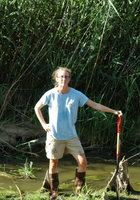Laura Triplett
| Geology
| HOME |

Laura and Phragmites australis, an invasive species of grass, in the Platte River
Laura and Carson Smith (Geology '11) collecting sediment samples in the Platte River
Silica transport in rivers
Rivers are the primary source of silicon to coastal ocean ecosystems, where it is often a limiting nutrient for important groups of phytoplankton like diatoms and radiolaria. An array of human activities have decreased the delivery of bioavailable Si (Si) from land to sea, which is a significant concern for marine ecosystems already under pressure from a variety of environmental changes. In this series of projects, we are evaluating the role of riparian (riverbank) vegetation in the transport of Si in rivers. Plants absorb dissolved silica (DSi) from water and transform it into amorphous particles (ASi) that accumulate in soils. Therefore, one factor that can alter the flux of Si in rivers is a change in vegetation cover in the active riverbed. Changes in riparian vegetation may cause significant reductions in riverine Si transport for two reasons. First, plants sequester Si by transforming DSi into ASi. Second, vegetation leads to reduced river flow velocity and increased deposition of suspended sediment, including ASi. Two highly-impacted rivers, the Platte River in Nebraska and the Green River in Utah, are serving as case studies to quantify the effect that riparian vegetation in general, and the invasive species of grass Phragmites australis in particular, have on Si transport to the ocean. Measurement of three pools of ASi – in riparian sediment, riparian vegetation, and suspended sediment in the river – and DSi in the river are being used to determine the magnitude of the vegetation effect. This project ties together silicon geochemistry, plant identification and characterization, and particle transport and deposition to develop a holistic understanding of the physical-biological-biogeochemical interactions controlling riverine Si transport.